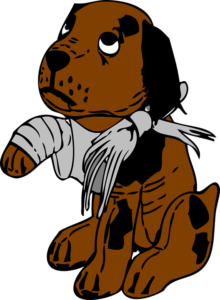
A torn CCL is degenerative and causes a dog a lot of pain
A cranial cruciate ligament or CCL refers to an important ligament in the stifle joint or knee. When a CCL tears, it results in partial or complete joint instability, allowing the tibia to slide along the femur. This causes pain and inflammation and, if left untreated, can lead to severe arthritis down the road. Today we’re going to go over the diagnosis of a torn CCL, its treatment, and a detailed look into the recovery process.
Symptoms/Diagnosis
Common symptoms for a torn CCL in dogs include:
- Hind Limb Lameness
- Decreased Range of Motion
- A Hind Leg Extending When Sitting
- Noticeable Pain When You Touch the Stifle Joint or Knee
- Stiffness After Exercising
- Swelling
We’ll diagnose your canine companion by performing a clinical examination and sedated radiographs that we will send over to Dr. Fallon, a surgical specialist, for review and confirmation. A dog can injure their CCL due to trauma or running and planting their hind limbs while their body’s momentum continues to move forward.
Treatment
Our own, Dr. McGee, performs Extracapsular Lateral Suture Stabilization (ELSS). This surgery provides stability to a dog’s knee by counteracting the tibial thrust with a specially-placed suture. Dr. Fallon specializes in Tibial Plateau Leveling Osteotomy (TPLO). The TPLO surgery flattens the shin bone by rotating it. Thus, leveling the plateau and creating stability in the joint by eliminating the need for the cruciate ligament all together. Dr. Fallon will also apply plates and screws to ensure the bone to heals in the correct/rotated tradition. Dr. Fallon is a surgical specialist who comes right to Mount Carmel Animal Hospital so you can keep your pet with the veterinary team you know and trust!
Recovery
Four weeks after the surgery, our veterinarians will check to see how your canine companion is doing and your dog will enjoy a complimentary first underwater treadmill (UWT) session. Aquatic Therapy is beneficial because warm water in particular helps lessen pain, make tissues more connective, improve range of motion, strengthen muscles, boost endurance, prevent weight gain, and so much more! We recommend your dog participates for eight weeks. At the 12-week mark, our team will perform a radiograph to check the healing of your canine companion. Also, we cannot stress enough how much at-home physical therapy matters! We will send you home with a guide on at-home physical therapy that will give you a schedule for the different exercises to help your pup heal. Our physical therapy plan helps your dog build back strength without overworking the leg too early. Here is a short list of what you can expect to do at home after your dog has had TPLO surgery:
- Week 1: Ice Packs (5-10 minutes; 3-6 times a day); day four of week one: use warm compresses for 10-15 minutes before passive range of motion (PROM) exercises, then switch back to icing
- Weeks 2-3: Leash walks, PROM (flexing the joints, one joint at a time in a controlled manner), Bicycling (mimicking a bicycling motion) Weight-Shifting Exercises
- Weeks 4-8: Incline Walking, Cookie Stretch to hip (putting a treat towards one of your dog’s hips and encouraging them to stretch for it)
- Weeks 9-12: Backward Walking, Tug of War, Dancing
Here at Mount Carmel Animal Hospital, We’ll Treat Your Pets Like Family!
Mount Carmel Animal Hospital has been serving the Northern Baltimore/Southern York community for over 30 years and is proud to be an independently operated, small animal practice committed to excellence in veterinary medicine and client service. From grooming to wellness services, along with Canine Life Skills Training Courses, and surgical procedures, we have the expertise that will best serve the needs of you and your pet. Contact us at 410-343-0200 and follow us on Facebook!
